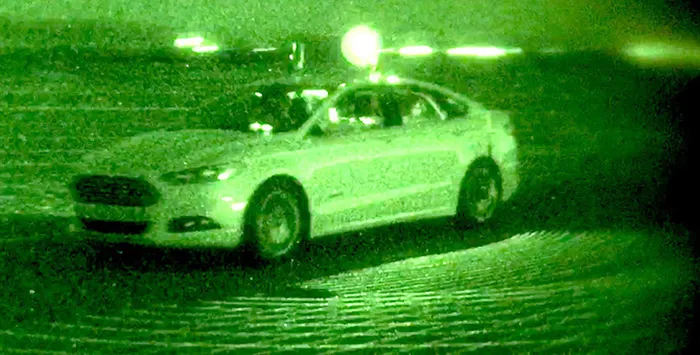Self-driving Fusion sees in the dark

Infrared LiDaR projection grid can be seen around the Fusion test car. Infrared LiDaR projection grid can be seen around the Fusion test car.
Wittman, Arizona - It's one of the scariest driving scenarios there is: you're cruising along an unlit country road and suddenly your car's lights go out.
It's bad enough for a human driver; for a self-driving car it's practically a guaranteed crash. Or it was.
As part of its Light Detection and Ranging sensor development program, Ford has been testing its autonomous Fusion hybrids at night, in complete darkness, at its Arizona proving ground, using a combination of LiDaR and 3D maps to allow them to 'see' where they're going.
LiDaR uses reflected laser beams - at 2.8 million pulses second - to map the car's surroundings in much the same way that radar does with radio frequencies. The car then compares the readings with very detailed 3D maps of its route - including information about the road, road markings, topography and landmarks such as signs, buildings and trees - to pinpoint its position in real time, and steer in the right direction.
Normally Ford's autonomous cars use input from three sources - cameras, radar and LiDaR - to map their surroundings, but the latest generation of sensors are accurate enough for the car to function on LiDaR alone, on roads without traffic lights.
Ford to invest in future mobility trends
Ford's technical leader for autonomous vehicles, Jim McBride said: "The test cars don't need sunlight or cameras detecting painted road markings - with LiDaR they can drive as well in pitch dark as they do in daylight."
For the Arizona test - and there are few places darker than the Painted Desert on a moonless night - Ford engineers wearing night-vision goggles monitored the car from outside as well as onboard.
The night-vision equipment actually allowed them to see the LiDaR grid of infrared lights beams projected around the car as it drove past.
One very brave scientist, Wayne Williams, rode in the back seat without goggles so he could follow the car's progress in real time using computer monitoring.
"Inside the car, I could feel it moving," he said. "But when I looked out the window, all I could see was blackness. Nevertheless, I could see on the computer screen it was staying right on track, along those winding roads."
Related Topics: